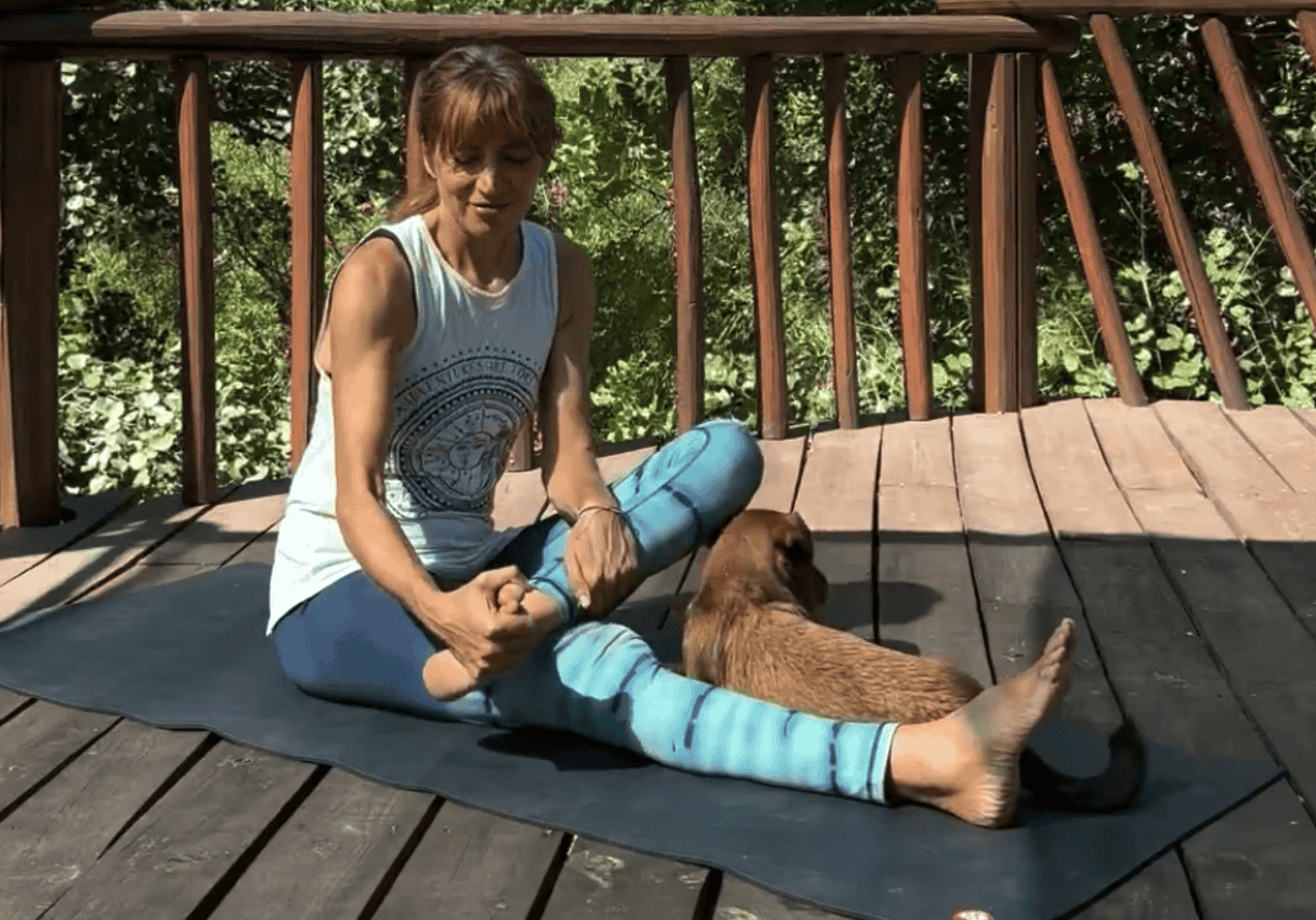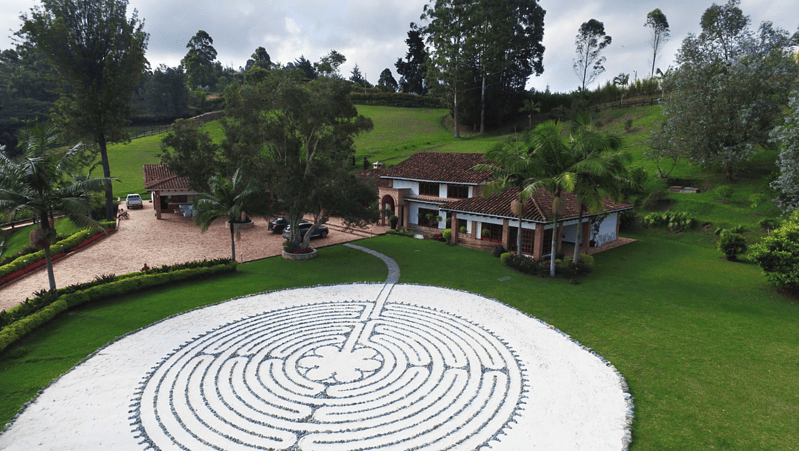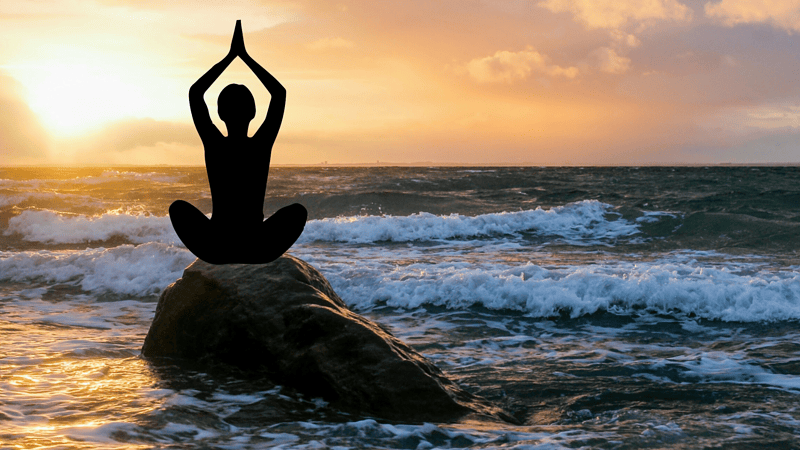
Discover the Power of Pawanmuktasana
Reading time: 5 minutes
The Pawanmuktasana series of exercises was developed by Swami Satyananda Saraswati to release stagnant energy in the body and therefore create a smooth flow of energy. In this article I hope to help us understand more about this little-known series of yoga exercises.
Satyananda believed these to be one of the most important groups of practices, and that if you do all three series very regularly, there will be significant reduction in chronic pain. He described them all in great detail, with directions, images, benefits and contraindications in his book, Asana Pranayama Mudra Bandha, first written in 1969.
Let’s begin with who was Swami Satyananda Saraswati?
Swami Satyananda Saraswati was born in India on December 25, 1923. He was an influential spiritual teacher, yogi, and guru known for his contribution to the popularisation of yoga worldwide. At the age of eighteen, he left home in search of a spiritual teacher and in 1943, he met his guru, Swami Sivananda, with whom he spent nine years, learning the knowledge of yoga, tantra, and Vedanta. Sivananda gave him a mandate ‘to spread yoga from door to door and shore to shore’.
Swami Satyananda Saraswati developed a systematic approach to yoga and brought to the public innumerable practices from ancient yogic and tantric scriptures, making them accessible and relatable to the modern world. He established the Bihar School of Yoga, Rikhiapeeth and many ashrams and institutions across the world, where he integrated various practices, including Hatha, Raja and Kriya yoga. His focus was on the holistic development of the individual and his teachings and works have influenced many worldwide.
Additionally, Satyananda wrote more than 80 books, among which is Asana Pranayama Mudra Bandha, a reference work for many yoga practitioners. Satyananda passed away on December 5, 2009, but his work and influence continue to inspire many seekers of spirituality around the world.
What is the Pawanmuktasana Series?
Pawan = air/wind/prana/vital breath | Mukta = free/release. | Asana = seat/posture/exercise.
Pawanmuktasana = yoga posture to expel inactive air in the joints and the body joints.
In the yoga tradition, it is believed that a subtle energy supports the physical body. We call this energy prana. It circulates in channels called Nadis. Yogis describe the flow of prana as a flow of Vayu (air/wind).
Stagnant energy is the cause of lack of energy, stiffness, and pain. Satyananda created the Pawanmuktasana series of asanas for all ages and all abilities. They are also designed as a preparatory practice for all major asanas.
When there is stagnant energy in the body, blocks are created where the stale air gathers, causing stiffness and often pain. Satyananda believed that it is this stagnant air that also causes arthritis. The Pawanmuktasana exercises create and maintain a smooth flow of energy in the body, to keep the body running efficiently. There are three series of Pawanmuktasana, each one having a series of exercises which should be followed in order, and one should not move onto the next series until they have mastered the first.
The gentle movements of Pawanmuktasana stimulate the natural healing processes:
- Created especially for people suffering from rheumatic arthritis and other joint problems
- Suitable for those who are recommended to avoid vigorous exercise.
- To be practised by anyone: beginner or advanced, young or elderly.
- Pawanmuktasana movement promote circulation of prana through all the Nadis (energy channels)
- Help develop awareness of the body and its movements
- As much as a mental practice as a physical one - Yoga raises the level of consciousness and establishes a better understanding between the mind and the body.
Prevents and remove any blockages preventing the free flow of energy in the body and mind.
Pawanmuktasana creates a very profound effect on the human body and mind a potent means to restore and maintain physical and mental health and they are essential for laying a firm foundation for the perfection of more advanced asanas.
Swami Satyananda Saraswati
‘Whether due to bad posture, disturbed bodily functions, emotional problems or an unbalanced lifestyle, energy becomes blocked resulting in stiffness, muscular tension, lack of proper blood flow and minor functional defects. If these blockages become chronic, a limb, joint or physical organ may malfunction, fail or become diseased. Regular practice of Pawanmuktasana can help remove energy blockages and prevent new ones, promoting total health by regulating and stabilising the flow of energy throughout the body.’ Asana Pranayama Mudra Bandha
There are three series, each targeting specific areas of our body and mind:
- Anti-Rheumatic for loosening joints of the body
- Digestive and abdominal group
- Shakti Bandha or energy block
These sequences become more challenging as they progress and the Pawanmuktasana Series 3 requires quite a bit of flexibility in the ankles, legs and hips, which are addressed in the earlier series.
The simple joint and muscle movements of Series 1 not only increase flexibility of the body, but also the mind. As the mind focuses on the movement, breath and energy, it begins to settle and relax. When performed correctly they tune up the autonomic nerves, hormonal functions and the activities of internal organs.
The asanas in each group should be performed in the order given. All three groups supplement each other, stimulating and encouraging a free flow of energy throughout the body. Perfect each group before attempting the next or other major asanas. Advanced yoga asanas are often physically demanding and have a powerful effect on the body and mind. It is essential to respect this and prepare correctly.
The whole body is systematically covered and as a result, joints that are normally underused are addressed. Certain movements influence blood flow, others massage internal organs and the spinal cord. Some exercises prepare your hips to sit in a meditation pose, others to stimulate your back.
Research shows (Journal of Sports Science and Nutrition 2022) that four weeks of Pawanmuktasana yogic training was effective in improving abdominal strength, back strength, and flexibility of physical education students. The study concluded that significant effect of Pawanmuktasana were seen on Abdomen strength, back strength and flexibility. Also, with the practice of Pawanmuktasana Anti- Rheumatic Series, early Arthritis Symptoms i.e., common joint inflammation was improved. Daily practice over a period of months brings about a profound relaxation and toning of the entire psycho-physiological structure which is necessary for the practice of advanced techniques.
The movement should never be ignored and treated casually just because the practices are simple, gentle and comfortable.
Swami Satyananda Saraswati
Part 1 - ANTI-RHEUMATIC GROUP
The asanas are very simple and yet they bring great benefits with regular practice:
- Rejuvenate the joint by activating the healing energies.
- Loosen up the joints of the body.
- Excellent for prevention and relief from rheumatism, arthritis, high blood pressure, heart problems or other ailments where vigorous physical exercise is not advised.
- Eliminating energy blockages in the joints of the physical body.
- Improve coordination, self-awareness, and self-confidence.
Part 2 - DIGESTIVE AND ABDOMINAL GROUP
The digestive system plays a significant role in the health of a person and this group of asanas is concerned specifically with:
- Strengthening the digestive system.
- It is excellent for people with indigestion, constipation, acidity, excess wind or gas, lack of appetite, diabetes, disorders of the male or female reproductive systems and varicose veins.
- Eliminates energy blockages in the abdominal area.
Part 3 - SHAKTI BANDHA OR ENERGY BLOCK
This group of asanas is concerned with improving the energy flow within the body:
- Breaking down neuro-muscular knots.
- Eliminate energy blockages in the spine, activate the lungs and heart, and improve endocrine function.
- The series is useful for those with reduced vitality and a stiff back and is especially useful for menstrual problems and toning the pelvic organs and muscles.
- It can be practised after pregnancy for re-toning flaccid muscles.
- The Shakti Bandha series may be started straight away if good health and fitness prevail. However, if there are any serious ailments, a therapist should be consulted. Also take care to observe the contra-indications given for individual practices.
How to practice:
With awareness of the movement of energy/prana. Prana may be experienced as a tingling sensation in the body
In a non-competitive and relaxed atmosphere with 100% concentration
Relax the muscles of the body – this sends impulses back to the brain and relax the mind.
Integrate the breath to keep the mind attentive so it does not wander off into tension and stress.
Right-handed people should lead with the left side to counterbalance the effects of habitual behaviour patterns and vice versa. This will also balance development of the limbs, nerves and behaviour patterns.
After every two or three practices, sit quietly in the base position with the eyes closed. Be aware of the natural breath, of the part or parts of the body that have just been moved. Notice any thoughts or feelings that come into the mind. This will not only rest the body but will also develop awareness of the internal energy patterns, and the mental and emotional processes. This rest period is almost as important as the asanas themselves and should not be neglected.
Mentally, one may feel light, yet one-pointed, emotionally fresh or tired. If tiredness is experienced at any point during the asana program, rest in Shavasana.
Shavasana should be performed for three to five minutes at the end of the program.
Usually, it takes a bit more than one hour to go through the Pawanmukutasana sequence. If you do the exercises thoroughly it can take a bit longer.
“The Pawanmuktasana series is one of the most important series of practices…”
Swami Satyananda in Asana Pranayama Mudra Bandha
The Science Behind Pawanmuktasana
Yoga is an ancient science and he Pawanmuktasana series has many benefits. Satyananda believed they help prevent arthritis by stimulating blood flow and increasing the flow of synovial fluid in the joints. He also thought that the ligaments get more supple and with practice, the range of motion can improve. Exercises also act on the blood circulation in the veins and in the lymphatic system whose role in eliminating waste is crucial. And when prana flows freely in the body it also flows better in the mind. The result is sharper thoughts and deeper meditations.
What is Synovial Fluid and How Does it Work?
Synovial fluid is found in many joints of the body. These joints provide the body's main movements such as walking, running and lifting and are present in all major joints like the shoulders, knees, hips, wrists, and elbows. They are the primary type, responsible for most of the body's mobility.
The job of this fluid is to lubricate the cartilage of the bone joints and provide nourishment through diffusion. As an example – a healthy knee contains about 1/3 of a teaspoon of synovial fluid.
It is made from an ultrafiltrate of blood plasma and is regulated by the synovium. Synovium is a thin connective soft-tissue membrane that lines the inside of some of your joints. They protect joints and help them move smoothly. Together with the bone, articular cartilage, tendon, ligament, and the fibrous capsule, it is an important component of the tissues that form an integrated joint.
Lubrication: Synovial fluid acts as a lubricant, reducing friction between the cartilage surfaces of the joint. This lubrication is essential for smooth, pain-free movement and prevents wear and tear on the cartilage.
Nutrient Supply: The fluid provides essential nutrients to the cartilage, which does not have a direct blood supply. These nutrients are crucial for maintaining healthy cartilage and promoting its repair and regeneration.
Shock Absorption: Synovial fluid helps absorb shock and distribute loads evenly across the joint surfaces, which reduces the stress placed on any single part of the joint. This helps prevent damage and maintains joint function.
Removal of Debris: It helps in the removal of metabolic waste products and debris from the joint cavity, maintaining a clean environment that supports joint health and function.
Why is Gentle Exercise Good For Us?
Physical activity stimulates the production of synovial fluid and disperses it around the joint evenly:
It helps prevent stiffness, keeps joints agile, and promotes the circulation of nutrients to joints.
Gentle, non-weight-bearing exercises are highly beneficial for joint health:
Particularly for individuals with joint issues or those who are recovering from injuries. By exercising with care, we also lessen the risk of injury or falling.
Bones need strong muscles for support:
Not exercising weakens those supporting muscles. Weak muscles put more stress on joints. Exercise also delivers nutrients, like vitamins and oxygen, to all parts of the body and nourishes the fibroblast cells which play an important role in regulating inflammation.
Exercise reduces stress:
Stress decreases collagen and hyaluronic acid production and causes existing collagen fibres to break down. Exercise decreases stress, which increases oxytocin and lowers cortisol—key hormones that have been thought to relieve pain of joint and muscle. Oxytocin can also help us bond with loved ones and can be released through touch, music and exercise. Cortisol is an essential hormone that affects almost every organ and tissue in your body. It plays many important roles, including regulating your body's stress response, suppressing inflammation, helping control your body's use of fats, proteins and carbohydrates, or your metabolism.
Exercise increases joint movement:
Lubricin in our joints is the most lubricating and anti-adhesive molecule in the human body. Lubricin molecules coat the cartilage surface. It increases with joint movement. In healthy joints, lubricin molecules cover the cartilage surface to lubricate the boundary of the joint and inhibit protein and cell attachment. Exercise also activates collagen, which provides structure, support or strength to your skin, muscles, bones and connective tissues.
Exercise strengthens the muscles, ligaments and tendons:
When these tissues are strong, they act like a brace to protect the joint and lessen pressure on weakened joints. For example, the quadriceps muscles in your thighs support your knee joints, and strong muscles in the lower back can protect your spine and hip joints. By strengthening these muscles, you reduce the load on your joints and decrease the risk of injury and pain.
Exercise reduces Inflammation:
Chronic inflammation is a common contributor to joint pain and damage. Exercise can help combat inflammation by promoting the release of anti-inflammatory cytokines in the body.
Exercise Increasing blood flow to joints:
Movement gets the heart pumping, which increases blood circulation throughout your body — including your joints. Circulation ensures that the joints are exposed to a steady supply of nourishing oxygen and nutrients, which are vital for repair and maintenance. Additionally, exercise triggers a biological process called autophagy, where damaged cells in the joint are broken down and removed. “It’s basically like taking out the trash,” explains Dr. Hardin.
Exercise supports joint flexibility:
Regular exercise, especially activities like yoga, tai chi, walking and stretching, can improve joint flexibility. Doing these activities regularly can increase the range of motion in your joints, relieving pain and stiffness.
Exercise and Arthritis
Everyone needs exercise, but it's especially important for people with arthritis:
- Exercise increases strength and makes moving easier.
- Exercise reduces joint pain and helps fight tiredness.
- The key is to start gently - there's no need to run a marathon or swim for miles – simple, moderate exercise can ease pain and help you stay at a healthy weight and when arthritis tries to slow you down, exercise can help keep you moving. (Check with your health care provider first)
Movement from an Ayurvedic and Chinese Medicine Perspective
In the 70’s, the Japanese doctor Hiroshi Motoyama studied the Pawanmuktasana. Dr Motoyama, a research scholar specialised in designing equipment to measure subtle energy flows. Here is a summary from his article ‘Investigating Pawanmuktasana - On the basis of the Nadi and meridian systems’
The meridians in Chinese Medicine correspond to the Nadis of the yoga tradition. Qi corresponds to prana. The endpoints of each of the main meridians are situated in the extremities of the fingers and the toes. They are called sei points. For example, the sei point of the lung meridian is found at the tip of the thumb. That of the heart meridian is on the inside of the little finger.
The qi or prana enters and leaves the meridians at these points. The state of the energy in the endpoints reflects that of the flow of energy in the whole meridian. Little exercises like the bending your toes or fisting your hands stimulate the sei points in a way similar to that of acupuncture or acupressure.
Chinese Medicine also describes gen points or source points. You find these points in the wrists, the ankles and between these joints and the sei points. A disease in internal organs is often detected at the corresponding gen point. Following this logic, doing these rotations of the wrists and the ankles allows to normalise the functioning of internal organs and favour the health of the whole body.
The knee joints, the hips, elbows and shoulders all have gen points. Thus, they can play a role in the functioning of the internal organs.
You can find the original explanation of sei and gen points in the Yellow Emperor’s Classic of Internal Medicine. It is more than two thousand years old and contains the basic theory of Chinese Medicine.
In summary, Motoyama concluded:
- The meridians and Nadis seem to consist of connective tissue, and the body fluid flowing within this tissue is the physiological counterpart of ki energy or prana.
- This flow easily stagnates in joints with many bones and ligaments, and this stagnation results in rheumatism or neuralgia.
- Body fluid tends to accumulate and stagnate in the joints, and then the whole body gradually becomes fatigued.
- If any of the twelve meridian flows in the region of the joints deteriorates beyond a certain point, disease will develop in the internal organ controlled by that meridian.
- For these reasons, a series of exercises for fingers, toes, wrists, ankles, elbows, knees, shoulder and hip joints is useful for promoting good ki flow along the twelve meridians, for maintaining a healthy state and preventing disorders, and for curing illnesses.
In Ayurvedic (the science of life) medicine we have Marma points in the body. These are ‘energetic centres’ where the life-force accumulates and flows. The Marmas interact with the chakras and internal organs via the Nadis and Srotas (channels). These points cover both the front and back body, in muscles, tendons, ligaments, veins and joints. It is believed stimulation of these points through movement and pressure releases stagnant energy and stimulates your internal organs, hormones, and other chemicals to help support the needs of your body.
In both Ayuveda and Chinese Medicine it is believed that in the wrists, the ankles there are energies which correspond to internal organs and rotations of these points helps to normalise the functioning of internal organs and improve the health of the whole body.
My Personal Reflections on Pawanmuktasana
On my own journey, the Pawanmuktasana series has supported me through injury and helped me really pay attention to my body and movement and what initially seemed like simple movements gradually revealed themselves nourishing way for healing both body and mind. I've found that these gentle practices offer a perfect balance to the more intense asanas in my yoga routine, especially on days when my energy is low or when my body craves something softer.
With my yoga teacher hat on – I will often choose a variation of one or all three of the series as a basis to my class warm ups, and if I am teaching those that need to move slowly, I might create an entire class based on the Pawanmuktasana series. Over time, I’ve noticed how this has helped my students with increased strength, joint mobility, less pain and most importantly, a deeper sense of inner calm and connection.
For anyone new to this series, I encourage you to approach it with patience. The beauty of Pawanmuktasana lies in its simplicity and subtlety, so be mindful of each movement and breath. Even if the movements feel easy, remember that yoga is as much a mental practice as it is a physical one. Allow yourself to tune into the energy flowing through your body, and you might be surprised at the deep relaxation and healing these exercises can bring.
As I continue to practice and share these techniques, I'm reminded that yoga is truly for everyone—no matter where you are in your journey. Whether you're dealing with joint pain, stiffness, a busy mind, or just looking for a way to connect more deeply with your body, Pawanmuktasana offers a gentle but powerful path forward.
To experience the power of these simple exercises, I have created an online course - Unlocking Energy Flow and Healing Through Gentle Yoga. Each exercise is explained in a detailed video, plus there is a full 1 hour practice focused on the entire Pawanmuktasana Series 1 practice. I am excited for you to explore it for yourself, and experience the all of the ways it can support your overall well-being.
With love and kindness,
Louise





